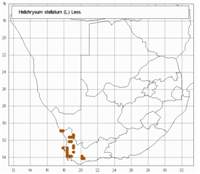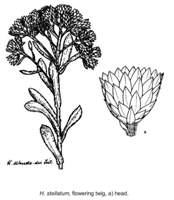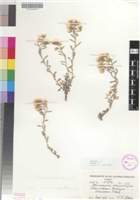Origin of name:
stellatum = starry or stallate hairs
Diagnostic characters:
Medium-sized heads, sub-globoseSolitary heads or small groupsOuter bracts brownish to cream, inner bracts whitish or pinkish
Description:
Bushy half-shrub 100-450 mm tall, woody at the base and much branched there, with numerous fine roots, branches erect or spreading, simple or forked, thinly greyish-white woolly, leafy throughout. Leaves mostly 10-40 x 2-6 mm, diminishing slightly upwards, linear-oblong to spathulate, apex acute to obtuse, apiculate, base narrowed, half-clasping, often auriculate, margins flat or crisped, both surfaces grey-woolly. Heads heterogamous, broadly campanulate, c. 7 x 7 mm, many in terminal corymbose panicles. Involucral bracts in 7-8 series, graded, loosely imbricate, inner exceeding flowers, radiating, all lanceolate, acute or subacute, flat, outer pale to dark golden-brown, inner opaque milk-white, occasionally whole head suffused rose pink. Receptacle very shortly honeycombed. Flowers 59-142, 8-22 female, 50-117 homogamous. Achenes 0.75 mm long, glabrous or with myxogenic duplex hairs. Pappus bristles many, about equaling corolla, scabrid, tips barbellate, bases nude, not cohering.
Flowering mainly in September and October.
Distribution:
Grows in sandy places. Endemic to the Western Cape, from Vanrhynsdorp and Calvinia districts south to the Cape Peninsula and Worcester and east to Montagu and Swellendam.
Fynbos and Succulent Karoo Biomes.
Notes:
Sometimes confused with H. cochleariforme but easily distinguished by the flat, acute or subacute, not concave and obtuse, involucral bracts.
Taxonomy:
Literature:
Helichrysum stellatum (L.) Less., Syn. Comp. 279 (1832); DC., Prodr. 6: 174 (1838); Harv. in F.C. 3: 220 (1865); Moeser in Bot. Jb. 44: 292 (1910).
Type:
Lectotype: specimen from which Burmann, Rar. Afr. Pl. t. 80, fig. 1 was prepared (G-DC).
Synonym(s):
Gnaphalium stellatum L., Pl. Rar. Afr. 19 (1760), Amoen. Acad. 6: 98 (1763).
G. pyramidale Berg., Descr. Pl. Cap. 255 (1767), non Thou. (1811). Type: Cape of Good Hope, Grubb (STB, holo.).
G. plenum Burm. f., Prodr. Fl. Cap. 25 (1768). Type: Specimen in herbarium Burm. (G).
G. carneum Lam., Encycl. 2: 741 (1788). Type: Cape of Good Hope (P-LAM).
G. congestum Lam., l.c., non Helichrysum congestum Moench (1802). H. congestum (Lam.) D. Don in Sweet, Hort. Brit. 223 (1826), nom. illegit. Type: Cape of Good Hope (P-LAM).
G. fulvum Lam., Encycl. 2: 743 (1788). Type: Cape of Good Hope (P-LAM).
Xeranthemum fragrans Andr., Bot. Rep. 9, t. 561 (1809). Helichrysum fragrans (Andr.) Lindl. in Loudon, Encycl. 702 (1829). Type: cult. Clapham 1803, no specimen found.
H. stellatum var. laxum DC., Prodr. 6: 174 (1838). Lectotype: Cape, Stellenbosch div., Zwartland, Rie beekkasteel and Paardeberg, Ecklon 444 (G-DC).
Vouchers:
Compton 11769 (NBG); Esterhuysen 16005 (BOL; NBG); Hall 4508 (NBG; PRE); Pillans 8739 (NBG; PRE).


